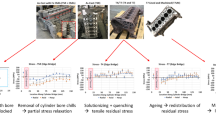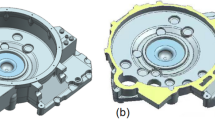Abstract
The latest generation of high-performance engine blocks are produced with the precision sand casting process (PSCP). Their enhanced mechanical properties are provided by an integrated cast iron chill in the bulkhead section and thus result in large variations in secondary dendrite arm spacing (λ2) throughout the whole casting, providing unique challenges in both heat treat (T7 temper) development and compliance to the CQI-9 protocol. This research examines the influence of chemistry, controlled solution/quench, residence time between quench and the start of artificial age and artificial age temperature, on the mechanical properties and cryogenic testing observations on PSCP engine blocks. The results are obtained from large population engine block castings (n = 204), heat treated within an industrial plant environment with strict control over furnace temperature gradients. The results indicated that age temperature differences of as little as 4 °C (within CQI-9 for furnace temperature specification of ± 5 °C) can alter yield strength and elongation significantly, which in turn changes crack susceptibility (warranty issues). In addition to the above analysis, it was found that extending the time between the solution/quench operation and the start of artificial age results in a continual drop in yield strength due to the influence of natural aging.





















Similar content being viewed by others
References:
C.F.R. Hernandez, J.M.H. Ramirez, R. Mackay, Al–Si Alloys, 1st edn. (Springer, Gewerbestrasse, 2017), p. 237
Special Process: Heat Treat System Assessment(CQI-9), 2nd ed. (AIAG: Southfield Michigan, USA, 2007), pp.70
L. Bäckerud, E. Krol, T. Tamminen, “Solidification Characteristics of Aluminum Alloys”. Vol. 1, “Wrought alloys”, (AFS/Skanaluminum, 1996), pp. 156
M.H. Mulazimoglu, N. Tenekedjiev, B.M. Closset, J.E. Gruzleski, Microstructure and Thermal Analysis of Strontium Treated Aluminium-Silicon Alloys (American foundry society, Inc., Cincinnati, 1997), p. 116
G. E. Byczynski, R. I. Mackay, ‘‘The Nemak Cosworth Casting Process: Innovation’’. Accepted for the TMS 138st Annual International Meeting and Exhibition, Shape Casting: 3nd International Symposium, ed. by Paul N. Crepeau, M. Tiryakiog˘lu, J. Campbell, (San Francisco, California, 2009), pp. 17–19
E. Sjolander, S. Seifeddine, The Heat Treatment of Al–Si–Cu–Mg Casting Alloys. J. Mater. Process. Technol. 210, 1249–1259 (2010)
F.H. Samuel, A.M. Samuel, H.W. Doty, Factors Controlling the Type and Morphology of Cu-Containing Phases in 319 Al Alloy. AFS Trans. 104, 893–901 (1996)
R.I. Mackay, D. Szablewski, The Use of Weibull Statistical Method to Assess the Reliability of a Development Engineered Automotive Casting Component. Int. j. Metalcasting Winter 4(4), 31–45 (2010)
J. Campbell, An Overview of the Effects of Bifilms on the structure and Properties of Cast Alloys. Metall. Mater. Trans. B-Phys Metall. Mater. Sci. 37B, 857–863 (2006)
A. Lombardi, F. D’Elia, C. Ravindran, B.S. Murty, R. MacKay, Analysis of the Secondary Phases in the Microstructure of 319 Type Al Alloy Engine Blocks using Electron Microscopy and Nanoindentation. Trans. Indian Inst. Met. 64, 7–11 (2011)
A. Lombardi, C. Ravindran, R. MacKay, Optimization of the Solution Heat Treatment Process to Improve Mechanical Properties of 319 Al Alloy Engine Blocks using the Billet Casting Method. Mater. Sci. Eng., A 633, 125–135 (2015)
L. Colley, M. A. Wells, R. Mackay, W. Kasprzak, “Dissolution of Second Phase Particles in 319-Type Aluminum Alloy”. Submitted to the ASM Heat Treating Society 2011 Conference
A. M. de Figueredo, Y. Sumartha and M. C. Flemings, ‘Measurement and Calculation of Solid Fraction in Quenched Semi-Solid Melts of Rheocast Aluminum Alloy A357’. In ‘Light metals Conference, Warrendale’, ed. by B. Welch, (The Minerals, Metals and Materials Society, Warrendale, 1998), pp. 1103–1106
M.A. Gafur, M.N. Haque, K.N. Prabhu, Effect of Chill Thickness and Superheat on Casting/Chill Interfacial Heat Transfer During Solidification of Commercially Pure Aluminium. J. Mater. Process. Technol. 133(3), 257–265 (2003)
V. Firouzdor, M. Rajabi, E. Nejati, F. Khomamizadeh, Effect of Microstructural Constituents on the Thermal Fatigue Life of A319 Aluminum Alloy. Mater. Sci. Eng A A454, 528–535 (2007)
F. F. Mehr, S. Cockcroft, D. Maijer, R. MacKay, W. Marquardt, “Assessment of the Impact of Water-Cooled Chill Technology on Microstructure Length-Scales in an A319 Engine Block Casting”, COM2017
R. MacKay, M. Djurdjevic, J. H. Sokolowski and D. Cusinato, “Using the Method of an In-situ Thermal Analysis Array in a Cast Section of an Engine Block Casting to Diagnose the Cause of Shrinkage Porosity”. In 131st TMS Annual Meeting, (Seattle, Washington (USA), 2002), pp. 17–21
R. MacKay, J. H. Sokolowski, “The Development of Thermal Analysis Partitioned Parameters for the Determination of Cast Aluminum Structures, Invited for the ASM 2002 Materials Solutions Conference, (Columbus, Ohio, 2002),pp 7–10
R. Mackay, J. Sokolowski, Experimental Observations of Dendrite Coarsening & Al–Si Eutectic Growth in Progressively Quenched Structures of Al-Si-Cu casting Alloys. Inter. Metalcast. 2, 57–75 (2008). https://doi.org/10.1007/BF03355428
Author information
Authors and Affiliations
Corresponding author
Additional information
Publisher's Note
Springer Nature remains neutral with regard to jurisdictional claims in published maps and institutional affiliations.
Rights and permissions
About this article
Cite this article
Mackay, R., Elsayed, A. & Byczynski, G. Novel Approach to Thermal Processing Development for Precision Sand Casting Process (PSCP) of Aluminum Engine Blocks. Inter Metalcast 15, 930–951 (2021). https://doi.org/10.1007/s40962-020-00526-y
Received:
Accepted:
Published:
Issue Date:
DOI: https://doi.org/10.1007/s40962-020-00526-y




